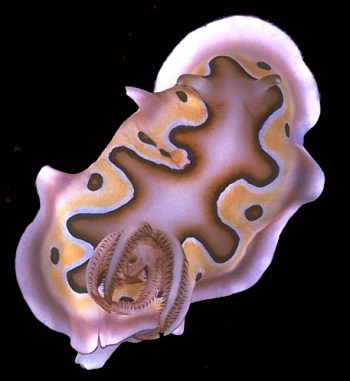
Chromodoris coi
(Risbec, 1956)
Order: NUDIBRANCHIA
Suborder: DORIDINA
Superfamily: EUDORIDOIDEA
Family: Chromodorididae
DISTRIBUTION
Tropical western Pacific
PHOTO
UPPER: Noumea, New Caledonia, October 1988. PHOTO: Bill Rudman.
LOWER LEFT: Lizard Is., Queensland, February 1981. PHOTO: J. Fields.
LOWER RIGHT: Granite Head, Lizard Is., Queensland, 10m, October 1979. PHOTO: R. Kuiter.
Originally described from Vietnam, it is well-known throughout the tropical western Pacific. The central region of the mantle is outlined by a sinuous purple line, a feature it has in common with a probable sibling species from the Indian Ocean, Chromodoris gleniei. The major points of difference are that in Chromodoris gleniei the central region is orange-brown with dark markings, while in C. coi the central region is a dull brown, sometimes with a darker mottling. Around the mantle edge of C. coi there is also a thin purple line, present only around the anterior end in C. gleniei. In both species, the underside of the anterior end of the mantle is deep purple, and in both species the whole of the mantle edge flaps rhythmically up and down as the animal crawls along, as can be clearly seen in the bottom right photo.
Reference:
• Rudman, W.B. (1987) The Chromodorididae Opisthobranchia: Mollusca) of the Indo-West Pacific: Chromodoris epicuria, C.aureopurpurea, C. annulata, C. coi and Risbecia tryoni colour groups. Zoological Journal of the Linnean Society 90: 305-407.
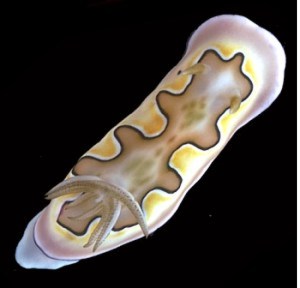
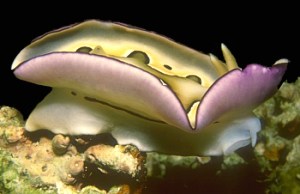
Rudman, W.B., 1999 (October 17) Chromodoris coi (Risbec, 1956). [In] Sea Slug Forum. Australian Museum, Sydney. Available from http://www.seaslugforum.net/find/chrocoi
Related messages
Chromodoris coi with eggs
November 24, 2009
From: Mirjam Broos
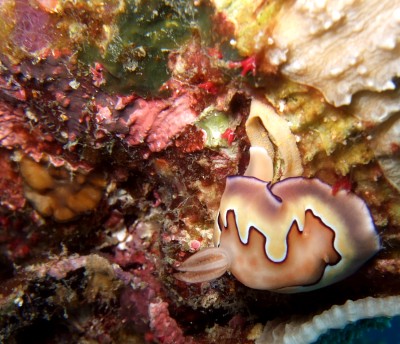
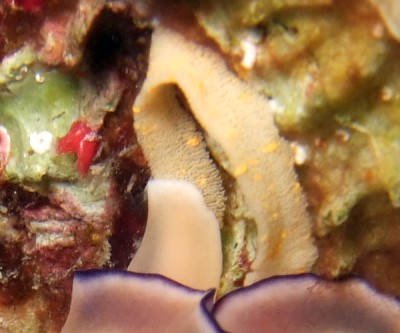
Dear John,
Going through some of our older pictures, I found some pictures of this Chromodoris coi with eggs. I thought it would be nice to share them.
Locality: Cabilao, Bamboo reef, Philippines, April 2008. Photographer: Geert Prast.
greetings,
Mirjam
mirjam.broos@planet.nl
Broos, M., 2009 (Nov 24) Chromodoris coi with eggs. [Message in] Sea Slug Forum. Australian Museum, Sydney. Available from http://www.seaslugforum.net/find/22792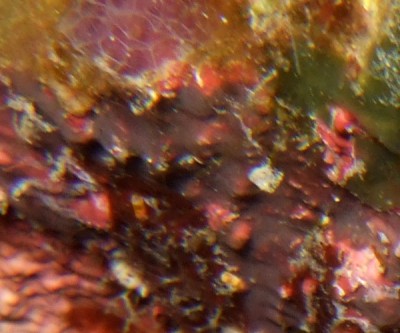
Dear Mirjam,
Thanks for another photo of this species' egg ribbon. As we see in an earlier message [#20191] this species has extracapsular yolk in its egg ribbon. Multiple reports are valuable because it shows that the extracapsular yolk in this species is not just the result of a single 'sick' animal.
Animals often lay their eggs near their food so when I get a photo with a lot of background I always scan around for potential food items. In the top left quarter of your photo I can see a dark purple growth which could well be Chelonaplysilla violacea which is the reported food sponge of this species. It is not definite proof but probably more than just a coincidence.
Best wishes,
Bill Rudman
Chromodoris coi with skeleton shrimp
February 20, 2009
From: Patricia Dilworth

I photographed this Chromodoris coi on a recent trip aboard the Pindito. The dive was at Kri Island - Raja Ampat at about 40 ft depth. When looking at the picture at home, I noticed the small skeleton shrimp on it's back.
Locality: Raja Ampat - Kri Island, 40 ft., Indonesia, 12 November 2009. Photographer: Patty Dilworth.
What fun!
Patty Dilworth
padilworth@aol.com
Patty Dilworth, 2009 (Feb 20) Chromodoris coi with skeleton shrimp. [Message in] Sea Slug Forum. Australian Museum, Sydney. Available from http://www.seaslugforum.net/find/22266
Dear Patty,
I guess this is in response to Valda Fraser's recent messages on caprellids 'infesting' various nudibranchs [see #22259].
Best wishes,
Bill Rudman
Chromodoris coi in Southern Leyte, Philippines
May 30, 2008
From: Carrie Lo
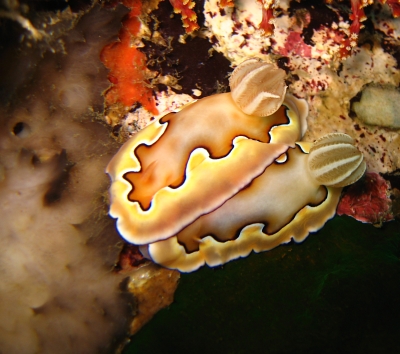
Concerning message #20191:
Dear Bill,
Here's a pair of mating Chromodoris coi found in Philippines.
Locality: Napantao, 15m, Philippines, 25 Dec 2007. Length: 2 inch. Photographer: Carrie Lo.
Cheers,
Carrie
carrielohc@yahoo.com.hk
Carrie Lo, 2008 (May 30) Chromodoris coi in Southern Leyte, Philippines. [Message in] Sea Slug Forum. Australian Museum, Sydney. Available from http://www.seaslugforum.net/find/21571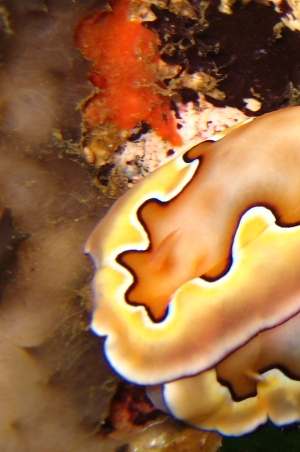
Dear Carrie,
When you find two nudibranchs closely together like this is does not necessarily mean they are mating. Since they have their genital openings on the right side of the body, they need to have their right sides together -starboard to starboard in nautical terms - to have any hope of mating. Which means they should also be facing in opposite directions. When you find them close together like this with their heads both facing the same way, it is often a sign they have found their food - in this case a sponge. If you look at the close-up photo alongside you will see that the lower animal seems to have its buccal bulb extended, which would support the idea that they are feeding. There is a dirty white looking sponge right in front of them, but it doesn't look like Chelonaplysilla violacea, which is the sponge this species has been previously found on [see #15477, #4924 ], but there is a dark brownish patch above the slugs which could be C. violacea. There are a few bits of the same dark sponge alongside the head of the lower chromodorid, so my guess is that your two animals are having feed.
Best wishes,
Bill Rudman
Chromodoris coi laying eggs
July 26, 2007
From: Kerem Turker
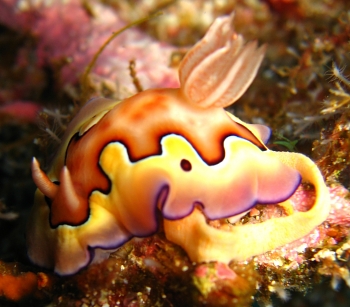
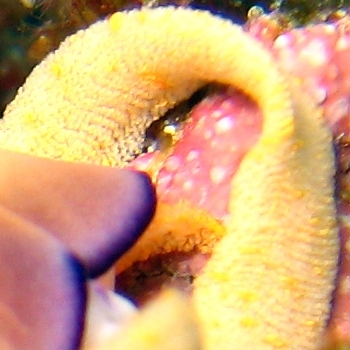
Dear Bill,
Here is a pretty lovely coloured chromodorid laying eggs. Although I am not sure, my guess will be Chromodoris fidelis. The geometry on the back is similar (with a dark dot on each side!!!) but the colour formation especially the deep yellow is not what I have found searching through the Forum.
Locality: Misool Island Raja Ampat, 15 meters, Indonesia, SW Pacific Ocean, 19 March 2007, Wall . Length: 40 mm. Photographer: Kerem Turker.
Regards,
Kerem
kerem.turker@pmintl.com
Turker, K., 2007 (Jul 26) Chromodoris coi laying eggs. [Message in] Sea Slug Forum. Australian Museum, Sydney. Available from http://www.seaslugforum.net/find/20191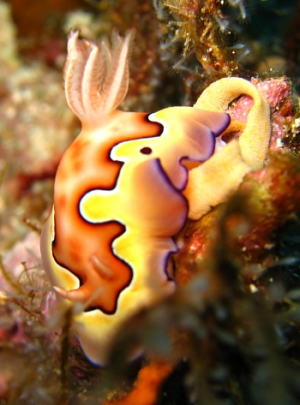
Dear Kerem,
Chromodoris fidelis has the 'tongues' of colour coming in from the edge of the mantle as in this species but ...... . Your animal is Chromodoris coi . Interestingly this species has extracapsular yolk in its egg ribbon just as in C. geometrica [see your recent message #20190 ].
Best wishes,
Bill Rudman
Re: Chromodoris coi from Solomon Ids
February 1, 2007
From: Scott Johnson
Concerning message #10199:
Hi Bill,
I was just looking through the messages on Chromodoris coi and came across your comment in message #10199 regarding the substrate the nudibranchs are on. I know this is a rather belated response, but that is indeed a sponge and it does look like the same sponge in the photo of C. coi from Pohnpei (message #3518 ). However, at least in the Pohnpei example, the nudibranch was not found on that sponge, and crawled across it apparently by chance during the photo session. It did not seem at all interested in stopping to try to eat. Of course, it was being regularly flashed with a powerful strobe, so that could have affected its behavior.
Scott
uwkwaj@yahoo.com
Johnson, S., 2007 (Feb 1) Re: Chromodoris coi from Solomon Ids. [Message in] Sea Slug Forum. Australian Museum, Sydney. Available from http://www.seaslugforum.net/find/21316Dear Scott,
Comments are never too late. At present the only direct evidence we have of C. coi feeding are the two messages on the Forum [#15477, #4924] of it on Chelonaplysilla violacea. If we get any more finds of it on that greyish sponge I guess we will need to try and identify it. If anyone has photos of this species feeding on or apparently 'at home' on a sponge I would be interested in seeing it, either to confirm it apparent choice of the purple Chelonaplysilla or to suggest it may like other sponges as well.
Best wishes,
Bill Rudman
Chromodoris coi laying eggs
January 23, 2007
From: Pasquale Pascullo
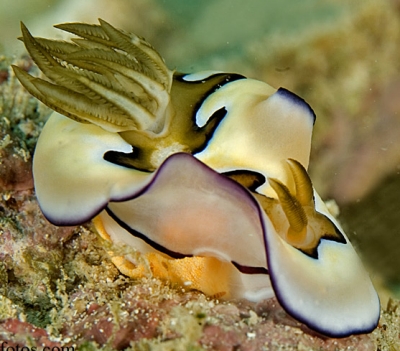
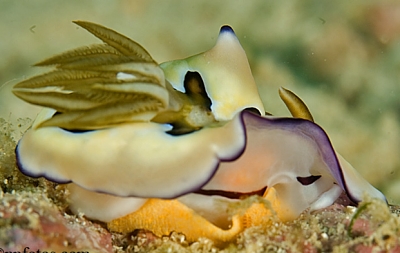
Hello Bill;
I found this animal laying eggs, and was able to get a side view/shot and actually see the eggs leaving the side of body. I always see shots of the eggs under an animal as the ribbon is being formed? I must also ask, do these eggs evolve, hatch, how long before they ?? do they get eaten?
This was laid out in the open, on a rock, which was laying on sand, in a strong current.
Locality: Ningaloo Reef , 30ft, Exmouth, Australia, Indian Ocean, Oct 2006. Photographer: Pasquale Pascullo.
Pasquale Pascullo
pp@ppfotos.com
Pascullo, P., 2007 (Jan 23) Chromodoris coi laying eggs. [Message in] Sea Slug Forum. Australian Museum, Sydney. Available from http://www.seaslugforum.net/find/19259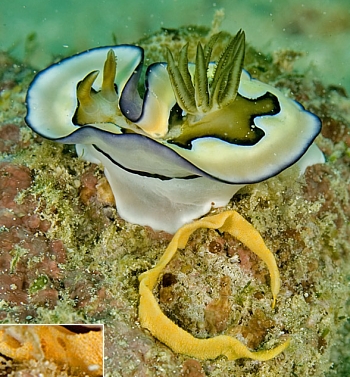
Dear Pasquale,
It's nice to get another record of Chromodoris coi laying this characteristic egg ribbon. As you can see clearly in an earlier message [#7229], this species has extracapsular yolk in its egg ribbon.
Concerning your other questions, I haven't found the time yet to prepare a page on larval development, but if you go to General Topics Index [Index at top left of each page] you will find a heading Life history, reproduction, mating and eggs which will lead you to some information on these topics. If anyone wishes to contribute some background Fact Sheets in this area they would be very welcome
Best wishes,
Bill Rudman
Chromodoris coi & sponges
December 15, 2005
From: Asther Lau

Dear Bill,
I came across this Chromodoris coi surrounded by different species of marine sponges. I guess the one it is on would be its food preference?
Locality: Mabul Is., Sabah, Malaysia.Celebes Sea Depth: 15 metres. Length: 4 cm. 15 March 2004. Muck divesite. Scattered rocky reef covered with sponges. Photographer: Asther M. Lau
Regards,
Asther M. Lau
asther@astherlau.com
Lau, A, 2005 (Dec 15) Chromodoris coi & sponges. [Message in] Sea Slug Forum. Australian Museum, Sydney. Available from http://www.seaslugforum.net/find/15477Dear Asther,
Yes the purplish sponge, Chelonaplysilla violacea, is the food of C. coi. Nice to get another record of the association.
Best wishes,
Bill Rudman
Extra-capsular yolk of Chromodoris coi?
June 10, 2005
From: M. Tay & J. Shahrizal
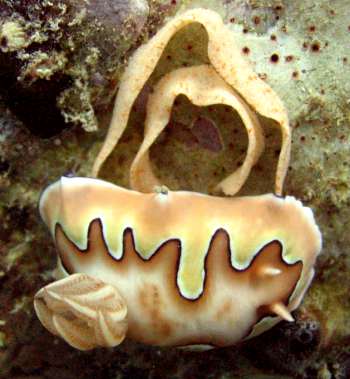
Hope this is an example of extra-capsular yoke of the eggs of Chromodoris coi. The orange "spots" are quite prominent in this example.
Locality: Labas Island, north west of Tioman Island, Pahang, Malaysia. South China Sea. Depth: 12 metres. Length: 7 cm . 9 June 2005. On small wall of island made up of giant boulders. Photographer: Michelle Tay
Michelle Tay & Jeffree Shahrizal
mail@eco-divers.net
Tay, M. & Shahrizal, J., 2005 (Jun 10) Extra-capsular yolk of Chromodoris coi?. [Message in] Sea Slug Forum. Australian Museum, Sydney. Available from http://www.seaslugforum.net/find/14013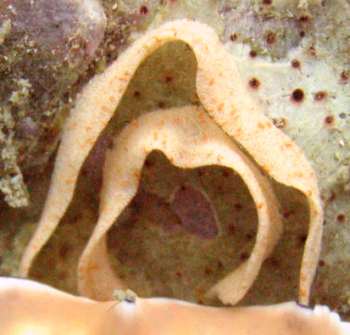
Dear Michelle & Jeff,
Yes this certainly looks like extra-capsular yolk. It is certainly nice to get another record to add to Kheong Sann Chan's earlier message [#7229]. We certainly have a lot to learn about the function of extra-capsular yoke.
Best wishes,
Bill Rudman
Chromodoris coi from Malaysia
May 16, 2005
From: Ho Wei Kwok Alvin

Here's a few shots of Chromodoris coi taken off the Dayang Jetty, Pulau Dayang in Malaysia.
Locality: Dayang Jetty, Pulau Dayang, West Malaysia. South China Sea. Depth: 5 m. Length: 40-50 mm. 2 May 2005. Jetty Pilings. Photographer: Alvin Ho
Regards,
Alvin
howeikwok@hotmail.com
Ho, W.K.A., 2005 (May 16) Chromodoris coi from Malaysia. [Message in] Sea Slug Forum. Australian Museum, Sydney. Available from http://www.seaslugforum.net/find/13764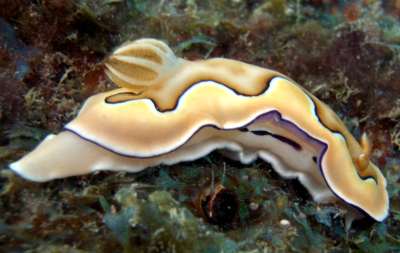
Thanks Alvin,
I have included the shot alongside as it shows the purple marks this species has on the body. We tend to forget that there are often colour patterns on the body and foot which are usually hidden in photographs. C. coi is also one of a group of species which has a deep purple patch on the underside of the mantle at the head end.
Best wishes,
Bill Rudman
Chromodoris coi from SE Queensland Australia
November 14, 2003
From: Gary Cobb

Hi Bill!
Please find attached a photo of a Chromodoris coi. Found on the west side of Old Woman Is Sunshine Coast Qeensland Australia. Depth 14m Size 40mm temp 22 degrees celcius.I took a photo of the same kind of animal a cuople of months ago and it did not have the two dark dots in the centre.
Thanks
Gary Cobb
gary@cobb.com.au
Cobb, G., 2003 (Nov 14) Chromodoris coi from SE Queensland Australia. [Message in] Sea Slug Forum. Australian Museum, Sydney. Available from http://www.seaslugforum.net/find/11380Thanks Gary,
The presence of spots is variable in this species
Best wishes
Bill Rudman
Chromodoris coi from Solomon Ids
June 13, 2003
From: Bruce Potter
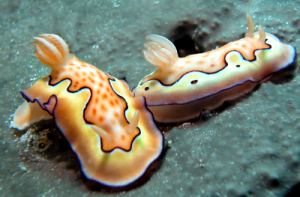
Dear Bill,
I have just returned from a weekend diving in the Florida group of the Solomon Islands. On a dive at Anuha island, we came accross these two Chromodoris coi at about 6 meters. They were about 35mm long, on a coral wall.
I was interested that the one with the more intense colouration had no spots around the mantle, while the paler one did have spots.
Regards
Bruce Potter
bruce.potter@adventist.org.sb
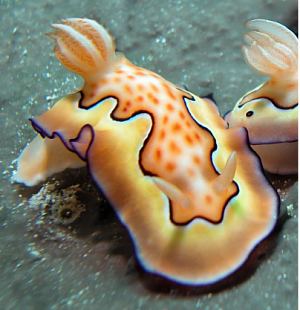
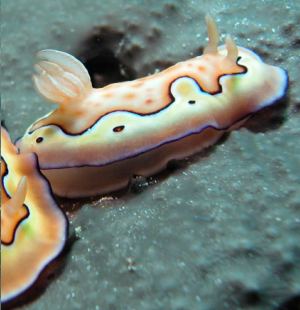
Thanks Bruce,
It's nice to get these colour variations. Also of interest is the greyish blue colony the animals are on. I wondered whether it was a sponge or an encrusting soft coral. However in Scott Johnson's photo [p008-3] of an animal from the Caroline Ids, it seems to be on the same thing. I must check to see whether it is a sponge.
Best wishes,
Bill Rudman
Chromodoris coi from Malaysia
July 17, 2002
From: Richard Houghton

Bill,
Here is a photo off Chromodoris coi found off Pulau Aur, Malaysia in May 2002.
Happy diving,
Rich
richard_houghton@hotmail.com
Houghton, R., 2002 (Jul 17) Chromodoris coi from Malaysia. [Message in] Sea Slug Forum. Australian Museum, Sydney. Available from http://www.seaslugforum.net/find/7469Thanks Rich,
Bill Rudman
Chromodoris coi from Malaysia (2)
June 16, 2002
From: Kheong Sann Chan
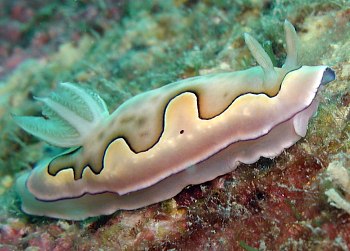
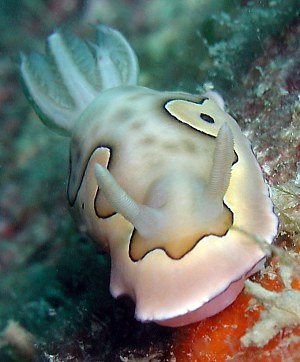
Here are some more photos from Pulau Dayang off the east coast of west Malaysia.
The last few are of the Chromodoris coi and there were a fair number of them around. Unfortunately my camera's batteries were dying at the end of the dive and could not shoot as many as I would have liked.
Location: Dayang, Pulau Lang
Date : 8 June, 2100
Depth : 15+m
Kheong Sann Chan
kschan@mail.dsi.nus.edu.sg
Chan, K.S., 2002 (Jun 16) Chromodoris coi from Malaysia (2). [Message in] Sea Slug Forum. Australian Museum, Sydney. Available from http://www.seaslugforum.net/find/7228Thanks Kheong,
This seems to be quite a regular find for you. perhaps it would be worth checking, next time you find it, to see if you can find which sponge(s) it feeds on. If you are lucky a photo of it on its food sponge would be very interesting. One way to check if it actually feeding or rather than just crawling past is to gently try and lift its head end and see if there is part of the animal protruding out of the mouth and attached to the sponge.
Good Luck
Bill Rudman
Chromodoris coi - extra-capsular yolk?
June 16, 2002
From: Kheong Sann Chan
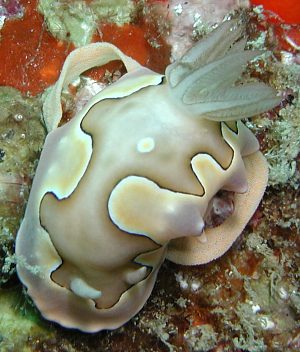
Here are some more photos from Pulau Dayang off the east coast of west Malaysia.
There were a fair number of Chromodoris coi around. Here are some shots of one laying eggs.
Location: Dayang, Pulau Lang
Date : 8 June, 2100
Depth : 15+m
Kheong
kschan@mail.dsi.nus.edu.sg
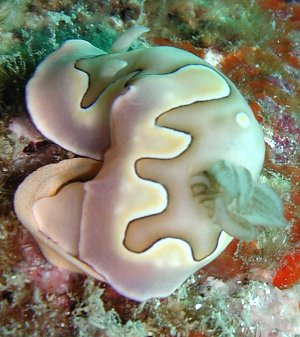
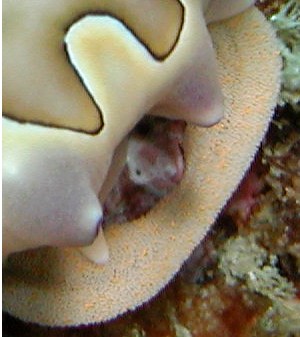
Dear Kheong,
Thanks for the photo. While preparing your photos noticed an peculiar feature so I have included a blow up of part of the egg mass. Apart from the whitish specks, which are the individual eggs, you can see scattered yellow patches. I think these patches are yolk material - a phenomenon known as extra-capsular yolk. Have a look at Scott Johnson's earlier message on the topic. I can't find any reference to C. coi in Boucher's (1983) paper on the topic so this may be a new observation.
• Boucher, L.M. 1983. Extra-capsular yolk bodies in the egg masses of some tropical Opisthobranchia. Journal of Molluscan Studies, 49(3): 232-241.
Best wishes,
Bill Rudman
Chromodoris coi from Malaysia
April 21, 2002
From: Kheong Sann Chan
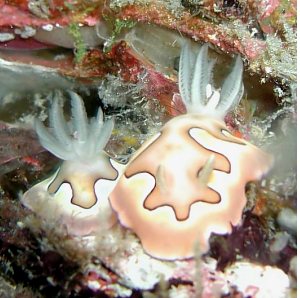
Hi Dr. Rudman,
Here is another nudibranch from Pulau Dayang off the East Coast of Malaysia on 14 April 2002. Depth varied approximately 15-23m deep.
Kheong.
kschan@mail.dsi.nus.edu.sg
Sann Chan, K., 2002 (Apr 21) Chromodoris coi from Malaysia. [Message in] Sea Slug Forum. Australian Museum, Sydney. Available from http://www.seaslugforum.net/find/6759Dear Kheong,
This is a pair of Chromodoris coi. It used to be known only from the southwestern Pacific so this more northern record is an interesting addition to our knowledge of the species.
Best wishes,
Bill Rudman
Chromodoris coi (the Marilyn Monroe of nudis)
February 22, 2002
From: Stuart Hutchison
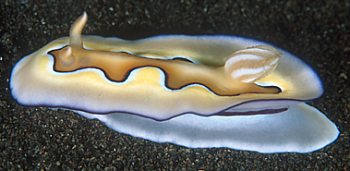
Bill,
This is one of my favourites - I think of it as the Marilyn Monroe of nudis. It was found on rocks in the intertidal zone on 18 Oct 2001, Bali, Indonesia. Length was approx 50mm. Typical 'flirting skirt' of this species!
Stuart
stuart@stuarthutchison.com.au
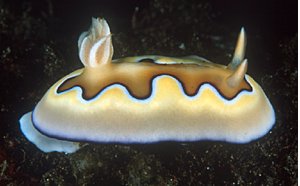
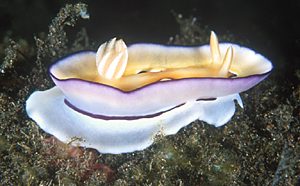
Thanks Stuart,
As you are no doubt aware, I am not a great fan of common names but that's a common name I could almost agree to use!
Bill Rudman
Chromodoris coi from Papua New Guinea
October 27, 2001
From: Marli Wakeling
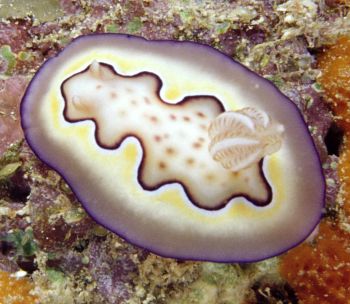
Hi, Bill,
Here is a Chromodoris coi that I found in August of 2001 in Papua New Guinea.
Dive Site: Baudisson's Island, near Kavieng, Papua New Guinea.
Date: August 1, 2001
Depth: 20 metres
Length: 50 mm
Marli
scubamarli@excite.com
Wakeling, M., 2001 (Oct 27) Chromodoris coi from Papua New Guinea. [Message in] Sea Slug Forum. Australian Museum, Sydney. Available from http://www.seaslugforum.net/find/5525Thanks Marli,
Bill Rudman
Chromodoris coi ? from the Solomon Ids
October 23, 2001
From: Ken Tucker

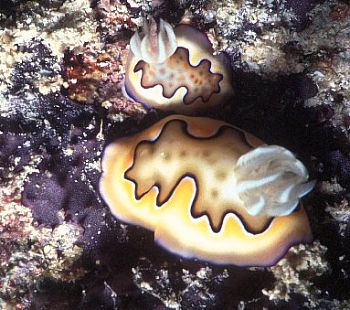
Dear Bill,
My best guess is Chromodoris coi, though these images look a bit different than on file. The only info I have is that I photographed them in the Solomons mid-1995.
Ken Tucker
ken@kilili.com
Tucker, K., 2001 (Oct 23) Chromodoris coi ? from the Solomon Ids. [Message in] Sea Slug Forum. Australian Museum, Sydney. Available from http://www.seaslugforum.net/find/4924Thanks Ken,
Despite the difference in colour between the two photos, the colour markings suggest they are the same two animals. What is interesting is the purple sponge they are apparently feeding on. It would be worth checking out whether this sponge was commonly associated with C. coi
Best wishes,
Bill Rudman.
Laying Chromodoris coi from Western Australia
March 27, 2001
From: Drew Taylor

Dear Bill,
Here is a photo of a Chromodoris coi laying eggs that was taken on 22 March 2001, on the Navy Pier, Exmouth, North West Cape, Western Australia, in 11 metres of water.
During this dive I also observed a pair of Hypselodoris bullocki mating beside two sets of egg ribbons, two Chromodoris elisabethina mating and a pair of Risbecia tryoni tailgating.
Regards
Drew Taylor
orcaunderwater@nwc.net.au
Taylor, D., 2001 (Mar 27) Laying Chromodoris coi from Western Australia. [Message in] Sea Slug Forum. Australian Museum, Sydney. Available from http://www.seaslugforum.net/find/4039Dear Drew,
Thanks for these interesting photos. You certainly picked a good time to go looking. I have separated or your photos into separate messages which I will post over the next couple of days.
Your photo of Chromodoris coi is quite interesting as it is probably the first record of this 'western Pacific' species in the Indian Ocean. I have long considered that another closely related species, Chromodoris glenei species replaced it in the Indian Ocean, however a recent message in the Forum shows, what looks like C. glenei, from the Solomon Ids.
The northwestern Australian fauna is obviously of a quite complex origin. While some of it is representative of an endemic Indian Ocean fauna, there seems to have been a mixing across the north of Australia with the Pacific fauna. Until a lot more collecting and study of the fauna of the northwest is undertaken, it will not be possible to sensibly interpret some of the strange colour forms and apparent 'species' we find there.
So your photos are of particular interest.
Best wishes,
Bill Rudman
Chromodoris coi from Pohnpei
January 22, 2001
From: Scott Johnson

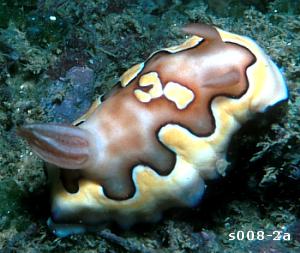
Hi Bill,
On a recent trip to Pohnpei in the eastern Caroline Islands, we came across a specimen of Chromodoris coi. While I know it is found at Chuuk, thanks to Mary Jane Adams' photo, I don't think it has previously been reported any farther east in Micronesia. We have not yet seen the species in the Marshalls, about 1000 km east of Pohnpei. The Pohnpeian C. coi is photo p008-3 (photo by Jeanette Johnson). I have also included a shot (s008-2a) of an individual from Guadalcanal in the Solomon Islands that has a couple of middorsal blotches.
Scott
johnson@kmr.ll.mit.edu
Johnson, S., 2001 (Jan 22) Chromodoris coi from Pohnpei. [Message in] Sea Slug Forum. Australian Museum, Sydney. Available from http://www.seaslugforum.net/find/3518Thanks Scott,
Bill Rudman
Photos of Chromodoris coi
September 10, 2000
From: Mary Jane Adams
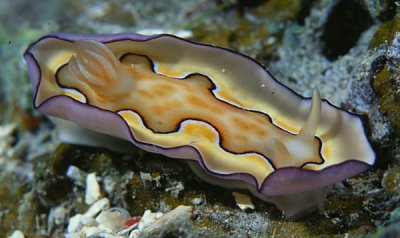
Hi Bill,
Thanks for your excellent presentation of Chromodoris preciosa. Here are some images for your Chromodoris coi page.
•UPPER RIGHT: I saw this one crawling on the encrusted hull of a ship wreck in Chuuk (Truk) Lagoon in January, 1992. It was the first time I had seen a nudibranch lifting it's mantle skirt as it crawled and I was totally enchanted. Depth: 10 meters Crawling length: 50 mm
•LOWER LEFT: This one has it's gills completely retracted. Ghavutu Island, Florida Group, Solomon Islands, November, 1994. Depth: 5 meters, length: 40 mm
•LOWER RIGHT: It looks like the tips of two of the gills have been nipped off. I guess that's why retractable gills evolved. Albatross Pass, New Ireland, PNG, August, 1997. Depth: 5 meters, Length: 44 mm
Best regards,
Mary Jane
mjadams@earthlink.net

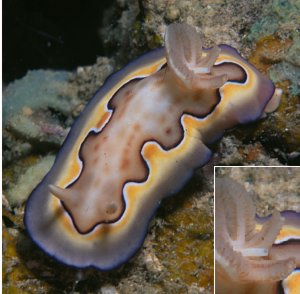
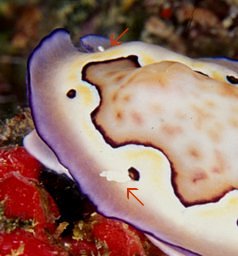
Dear Mary Jane,
Thanks for the great photos, which help bring this wonderful animal to life. One interesting feature I noticed in the Solomon Islands animal was that two of the mantle glands were partially extruded, much as I have seen previously in Chromodoris aureopurpurea. This is quite ineteresting because there is some debate over whether the structures which contain the distasteful chemicals in chromodorid mantles are actually able to secrete or discharge the substances they contain. No pores have been found in histological studies which have led one group to call these structures mantle dermal formations or MDFs for short. It is therefore nice to see that in at least some species the contents can escape from the mantle skin.
Best wishes,
Bill Rudman.
Chromodoris coi - mantle flapping
August 28, 2000
From: Claire Barnes
Dear Dr Rudman,
Just a sighting report of mantle-flapping Chromodoris coi in June at Mantanani in E. Malaysia (off north coast of Sabah) - depth 10m, sand-gravel bottom. It was flapping energetically and moving quite "fast". Other divers had been looking at it and may have disturbed it. I do have it on digital video so could check on speed.
Regards,
Claire
cbarnes@pc.jaring.my
Barnes, C., 2000 (Aug 28) Chromodoris coi - mantle flapping. [Message in] Sea Slug Forum. Australian Museum, Sydney. Available from http://www.seaslugforum.net/find/2937Thanks Claire,
Bill Rudman.
Chromodoris coi
October 17, 1999
From: Bill Rudman
To accompany the Chromodoris gleniei page I have posted for Erwin Koehler's message, I have also posted a page on the Western Pacific species, Chromodoris coi, which seems to be a sibling replacement species, of that Indian Ocean endemic.
Bill Rudman.
